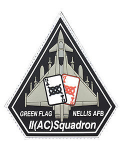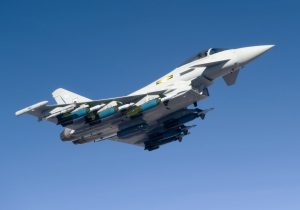2017-06-29 By Robbin Laird
During my visit to RAF Lossiemouth in March 2017, I got an update on the evolving experience of the Typhoon as an expeditionary force.
My discussion with the Squadron Leader for II(AC) Squadron, Martin Pert, highlighted the evolving experience of II(AC) Squadron with the aircraft.
Most recently, RAF Typhoons have been involved in both Red and Green Flag in the United States as the air to air and air to ground capabilities of the aircraft are evolving and their contribution to airpower enhanced.
Again they brought the latest version of Typhoon the P1eb.
The evolution of Typhoon and the arrival of the P1eb aircraft is described by BAE Systems as follows:
Phase 1 Enhancements Further Work (P1Eb FW) is an evolution of the current Tranche 2 Typhoon aircraft in service with the UK. The P1Eb standard Typhoons entered service last year.
P1Eb FW is the first part of the UK’s Project CENTURION, the package of enhancements which aims to deliver a seamless transition of capability from Tornado to Typhoon by the end of 2018.
The upgrades will bring numerous new capabilities, including additional Human-Machine Interface technologies and additions to the aircraft’s Air to Surface targeting capability.
These latest upgrades has successfully undergone trial installation and Operational Evaluation with 41 (R) Squadron, the RAF’s Test and Evaluation Squadron (TES) at RAF Coningsby, is now underway.
Flt Lt Luke Gili-Ross, from the RAF’s 41 (R) Squadron (TES), said: “The integration of P1Eb Further Work is an important and necessary incremental step towards Phase 2 Enhancements (P2E) for the aircraft. On the surface, it appears to deliver quite small improvements, but for the operator they may be significant in terms of the aircraft’s continued effectiveness.”
Paul Ascroft, Technical Lead for Project CENTURION at BAE Systems, said: “The achievement of the deliver of P1EB Further Work capability is an important milestone. Working with 41 Squadron, we are now undergoing Operational Evaluation and this is progressing well. This work is providing lessons learnt for the forthcoming packages, while achieving the first step on the journey and setting the standard of how the RAF and industry can work effectively together.”
Following the achievement of these latest upgrades to the aircraft, the first tranche of enhancements as part of Project CENTURION will continue with the delivery of the Phase 2 Enhancement package, which provides additional Human-Machine Interface and availability improvements, along with the initial integration of the Meteor Beyond Visual Range Air to Air missile and the Storm Shadow stand-off Air to Surface weapon.
The next and final upgrades deliver the Phase 3 Enhancement package which includes the final integration of Storm Shadow and Meteor capabilities, as well as the introduction of the Brimstone 2 close air support Air to Surface capability.

Squadron Leader Martin Pert came to Typhoon from Harrier so ground attack is not a foreign concept to him.
During Green Flag, he flew with USAF F-15 pilots in providing ground support to UK and US JTACs in the exercise.
He highlighted what he saw as a cultural transformation for Typhoon pilots in moving from a world where the core role was air superiority to becoming proficient multi-role pilots, in which ground attack was a core mission.
“We are a multi-role platform.
“We have a lot of junior pilots here who have been focusing on the air-air environment, attributable to the nature of operations II(AC) Sqn has conducted over the last 18 months to 2 years.
“The junior pilots who have been on the squadron during that period are now expected to change into a multi-role mindset where they need to be focused not just on the counter-air but into air to surface operations as well.”
Green Flag which is an air to ground exercise obviously was an important experience in this transition.
“The exercise itself hasn’t changed since I went to a Green Flag in the Harrier.
“It’s still the same problems, it’s still the same tactical flow of dealing with understanding ground commanders’ intent, using every possible asset you have available to you both on the ground and in the air, to prioritize and task focus.
“So actually, there was nothing mind bending or novel that came out of the exercise.”

And the exercise involves cross learning between the pilots and the JTACs with regard to what can realistically be delivered in the ground support role.
“I wouldn’t refer to it as a testing ground, but it’s a great proving ground for guys who’ve spent a lot of time in the synthetics and now doing it in the air combat environment.
“They are utilizing the kit that’s now new to them, and take it to the real world, and take it to the real guy who’s on the ground.”
The earlier Typhoons, Tranche 1 could drop only Paveway 2 which is a bunker busting type of capability.
Now the Typhoons carry Paveway IV and are being integrated with Storm Shadows and Brimstone as well so the arsenal for ground attack is evolving for Typhoon.
As Raytheon put it with regard to Paveway IV:
Raytheon UK is the design authority for Paveway™ IV bomb, which has all-weather strike capability and is deployable on Tornado GR4, Typhoon and the JSF.
The Paveway IV bomb is the latest generation guided weapon selected by the UK MOD for the Precision Guided Bomb program, and has been deployed since 2008 on all UK combat operations. The combat-proven dual-mode guidance, together with height-of-burst and penetrating capability in one weapon system, enables the decision of target engagement to be made right up to the point of release.
The Paveway IV bomb was successfully deployed with the RAF as part of Operations Herrick and Ellamy, achieving 98 percent accuracy. Raytheon UK-funded SPIRAL developments include moving target engagement capability, low-yield warhead variant, penetrator warhead development and range extension.
http://www.raytheon.com/capabilities/products/paveway-laser-guided-bomb/
Part of the cultural change, which Pert discussed, was shifting from the two seat Tornado with a weapons officer onboard to operating weapons from a single seat aircraft.
“We’re expecting these junior pilots to be on their own, working to the same level of fidelity that they’ve had prior to that with a guy in the back who’s sitting in the weapons manger’s seat and directing fire.”
Dynamic tasking is an especially challenging task to learn as well, and exercises like Red and Green Flag are crucial to the learning curve.
“You’ve been airborne for five or six hours already, and now you’re expected to go somewhere completely different to the situation and area where you have been briefed to operate, and now you have to execute a different mission set than you were expecting to perform.”
We discussed the impact of the F-35 as well on the way ahead.
“I see the F-35 as the whip-cracker, whether it be rear or forward, driving Typhoons around to complete the task using best available assets.
“With the Typhoon effectively as his work horse with the F-35 as a kind of goal-keeper.”
And as the RAF blends F-35 with Typhoon, the question of how best weaponize the combat fleet will become a key priority for shaping the way ahead.
“Weaponization of the Typhoon has been fairly well defined over the last ten years.
“Everyone’s known what the integration periods are going to be for which weapons.
“One thing that we just have to keep re-assessing as that process goes on is that are these actually the right weapons for the task that the jet is going to be asked to deliver?
“Should we add weapons for SEAD missions for example, as the F-35 becomes the forward deployed task master for such missions, aided significantly by strike assets from Typhoon?
“We need to ensure that we are not hamstringing ourselves with the weaponization process.
“We need to open the aperture as we reshape the air combat fast jet force.”
And as this process evolves the integration to other non-air assets becomes crucial as well, whether it is integration with naval assets from a strike or ISR/C2 point of view.
“We’ve built new Type 45 destroyers and are building new CVF Aircraft carriers and Type 26 Destroyers.
“The information soak from F-35 has to be taken into account as those new assets come into service.
“Are we utilizing that information in its best available capacity?
“It is way beyond ownership of one or the other service; it is about having an integrated combat force.”
Clearly, a major task facing the evolving combat force is dynamically tasking the weapons load from the air-naval force.
“We’re talking about pilot shortages or manning crises that we see on headlines every day.
“Who are the people that we really need to focus that training on?
“And how do you best use fliers at the moment?
“How do you best increase their corporate experience so that everyone’s knowledge is improved?
“I think we have to make decisions on who those people are going to be now.”
Editor’s Note: For our last interviews with II(AC) Squadron, see the following:
https://sldinfo.com/the-perspective-from-raf-lossiemouths-no-ii-ac-squadron-meeting-the-challenges/
This is the third in an eight part series based on a March 2017 visit to RAF Lossiemouth.

